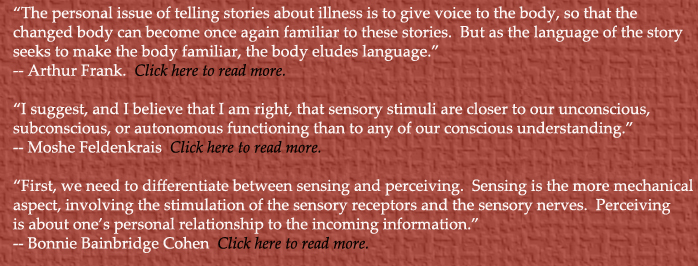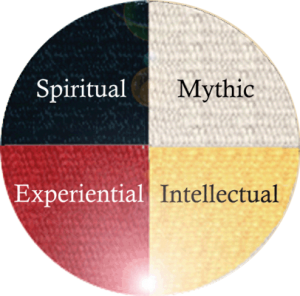
 Our brains process incoming sensory information from our eyes, ears, skin, nose, and mouth so quickly that sometimes we forget how much of what we know is perceived immediately, at initial contact. We know that a touch is friendly or not simply by its feel, as Moshe Feldenkrais explains in the full quote linked above, because there are ways of knowing about the world that reside in the body itself.
Our brains process incoming sensory information from our eyes, ears, skin, nose, and mouth so quickly that sometimes we forget how much of what we know is perceived immediately, at initial contact. We know that a touch is friendly or not simply by its feel, as Moshe Feldenkrais explains in the full quote linked above, because there are ways of knowing about the world that reside in the body itself.
The fact that we are embodied organisms affects us so profoundly that we ask to hold something we are shown, saying “Let me see it,” but meaning “Let me hold it.” So strong is the human urge to know things through touch, in fact, that museums of natural history routinely put plastic copies of bones at the ends of mounted skeletons within the public’s reach. They are touched so often by visitors that they require frequent replacement due to wear.
We all know why museum visitors feel they have to trail their fingers across the bones to truly know them. We have done things like that ourselves, even if not that precise thing, and we know what we were feeling at the time that motivated us to do it. The human experience may be hard to objectify, but its reality is nonetheless meaningful.
To explore an example of Experiential Ways of Knowing first-hand, visit Experiential Ways of Learning about Tornadoes.
To proceed around the Circle of Ways of Knowing, visit Spiritual Ways of Learning and Knowing.
To proceed around the Circle to the next direction, visit West.
You may use the table below to explore the directions, their associated ways of knowing and learning, and an example of each type of learning as applied to understanding tornadoes.
